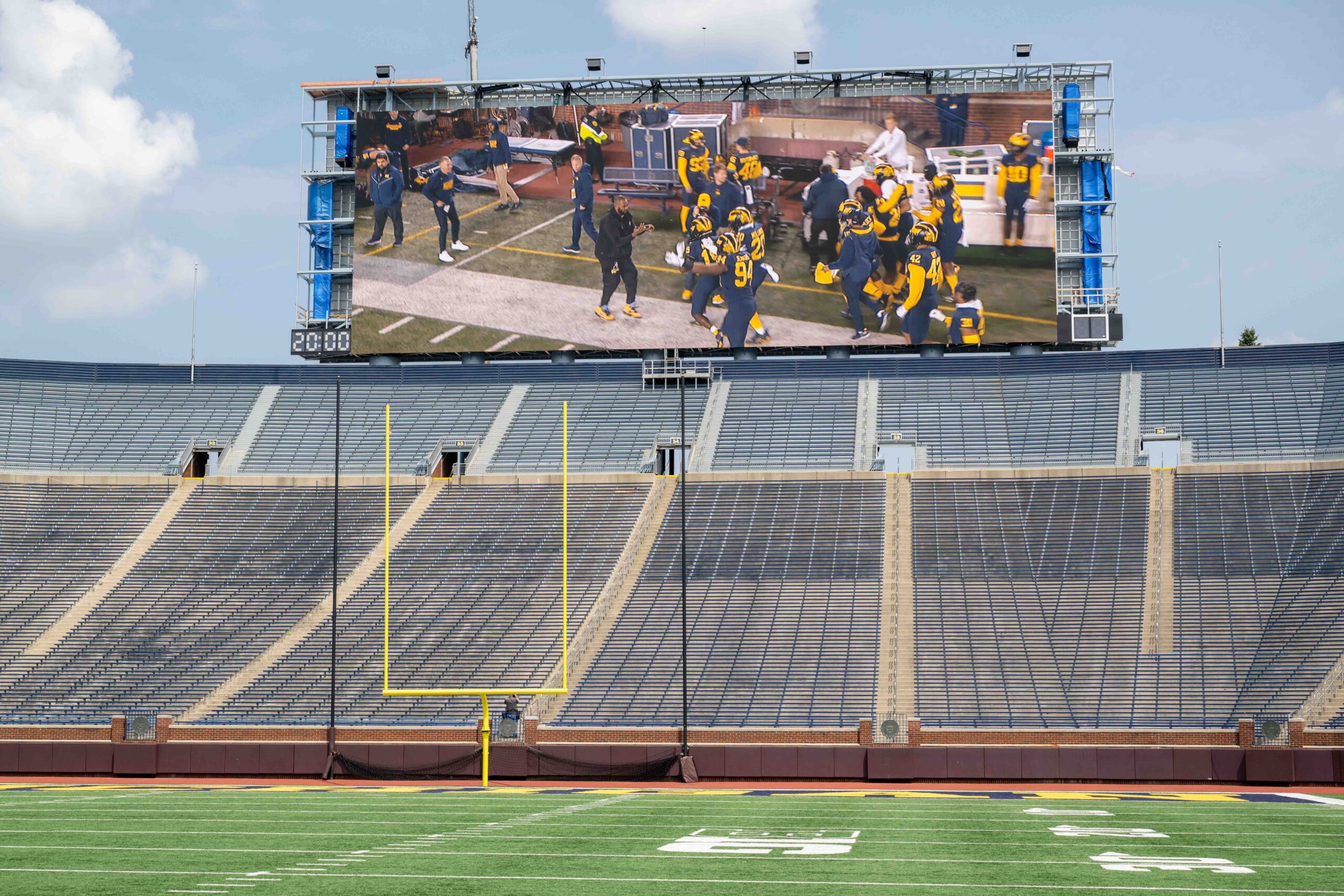University of Michigan Ups LED Footprint at Michigan Stadium With New End-Zone Videoboards
New lighting, audio systems have also been installed
Story Highlights
The University of Michigan has an illustrious history of excellence in football and, since the program’s early days at the beginning of the 20th century, has called the nearly century-old Michigan Stadium home. To maintain the venue’s reputation as one of the more famous stadiums in collegiate sports, as well as to modernize the game-day experience, the institution and its athletics department have installed new 179- x 62-ft. end-zone videoboards, a new LED lighting system, and an upgraded audio system at The Big House.
“The decision to replace our videoboards and accompanying infrastructure was practical: to keep pace with technological advances,” says Kurt Svoboda, associate athletic director, external communications and public relations, University of Michigan. “Our fans will benefit from experiencing true high-definition videoboard content with a significantly larger display and improved audio and lighting accompaniments.”
Altering Timelines: Spring Graduation, Venue’s Age Present Construction Challenges
The University of Michigan is a bustling campus with sports events and activities year-round. Though ideal for an enrolled student, the packed schedule of extracurriculars isn’t conducive to a technological facelift. Construction began immediately after the end of the team’s home schedule last November, but, as cold winter turned into spring, Michigan Stadium prepared to house commencement, presenting a knotty logistics challenge for Svoboda and his team.
“Altering construction timelines while servicing an event of that magnitude is a good example of what our project team balanced over the spring and summer months,” he adds.
To overcome the obstacle, the university relied heavily on its partners on the project, including Mitsubishi Electric as LED provider and Detroit-based Ideal Contracting for support columns and infrastructure. In turn, the partners leaned extensively on the expertise of a member of the university’s Class of 2013: Construction Project Manager Eric Miller led the athletics side. With Michigan Stadium among the 25 oldest college football stadiums in the nation, the venue’s age combined with the sheer size of the videoboards was another hurdle to clear.
“Each videoboard called for the addition of two outer columns to support the weight of the boards and protect against wind issues,” says Svoboda. “These columns weighed between 60 tons and 70 tons each and had to be transported to Ann Arbor one at a time from a factory in Pennsylvania.”
Big Boards in The Big House: Massive Displays Loom Over 107,000+ Fans
The new videoboards are 85% larger than the previous ones, which were 109 ft. high by 55 ft. wide. Since the venue’s most recent videoboard upgrade in 2011, the sports-broadcasting industry has undergone numerous changes. A systems integrator with knowledge in both professional and collegiate sports, Conference Technologies Inc. (CTI) played a vital role in adding HDR-capable solutions to the production-control room. This added flavor of video not only presented the production crew with the task of learning a new workflow but also forced a re-think on how footage and visuals are shot and displayed: for example, the LED display on the videoboards is 152 ft. high by 55 ft. wide versus the previous 85 ft. by 45 ft.
“Our video and event-presentation teams have spent many hours onboarding the new technology,” adds Svoboda. “This includes having to resize content to fit screens that are 118% larger than our previous boards.”
A centralized production model is deployed to produce in-venue shows for football games from the home of the men’s and women’s basketball: Crisler Center, located to the east of Michigan Stadium. The control room can be easily accessed by production personnel on game day. Since shows for all athletic venues are handled from the same location, each production uses the same equipment.
Other In-Venue Upgrades: Lighting, Audio Systems Complement Videoboard Installation
Along with the 16,700 sq. ft. of videoboards on the north and south sides of the venue, fans will be treated to new and improved lighting and audio systems. Following the trend of flashing LED lights during big moments in the game or team introductions, the University of Michigan recruited the services of Musco Lighting and the company’s Show-Light Pro Venue special-effects technology.
“The new lighting system will allow us to have custom light shows with light-to-music synchronization,” says Svoboda. “We’ll also utilize Musco’s TLC for LED technology, with light-control capabilities around the concourse. Both systems will reduce energy consumption by over 30% compared with our previous lighting solution.”
On the audio front, the system used throughout the years will be replaced with a new one for louder and more balanced sound throughout the lower bowl.
Football Productions for the Future: More LED Space Enhances Fan Experience
Anchoring in-venue shows, the larger videoboards will allow fans to see more information than what they’re accustomed to seeing. This includes in-depth statistics and out-of-town scores, which will keep fans engaged in the action on the field and help them understand what’s happening within the greater college-football landscape.
Given all the preparation done during the offseason, interdepartmental collaboration and teamwork has been essential to transforming what fans will eventually see on Saturdays in Ann Arbor. Led by Executive Senior Associate Athletic Director/COO Rob Rademacher, the effort comprised Associate Athletics Director, Facility Operations, Paul Dunlop; Assistant Athletics Director, Video Production, Colin McCarty; and Director, Game Presentation and Fan Experience, Jake Stocker.
Says Svoboda, “They have put enormous thought and work behind the scenes to ensure our systems are ready to go.”
Four of University of Michigan Football’s seven home games in 2023 will be played in September: vs. East Carolina on Sept. 2, vs. UNLV on Sept. 9, vs. Bowling Green on Sept. 16, and vs. Rutgers on Sept. 23.





